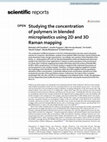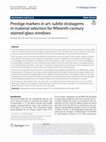Papers by Wendy Meulebroeck
HAL (Le Centre pour la Communication Scientifique Directe), Oct 1, 2017
HAL is a multidisciplinary open access archive for the deposit and dissemination of scientific re... more HAL is a multidisciplinary open access archive for the deposit and dissemination of scientific research documents, whether they are published or not. The documents may come from teaching and research institutions in France or abroad, or from public or private research centers. L'archive ouverte pluridisciplinaire HAL, est destinée au dépôt et à la diffusion de documents scientifiques de niveau recherche, publiés ou non, émanant des établissements d'enseignement et de recherche français ou étrangers, des laboratoires publics ou privés.

Scientific Reports
The combination of different polymers in the form of blended plastics has been used in the plasti... more The combination of different polymers in the form of blended plastics has been used in the plastic industry for a long time. Nevertheless, analyses of microplastics (MPs) have been mainly limited to the study of particles made of single-type polymers. Accordingly, two members of the Polyolefins (POs) family, i.e., Polypropylene (PP) and Low-density Polyethylene (LDPE) are blended and extensively studied in this work due to their applications in industry as well as abundance in the environment. It is shown that 2-D Raman mapping only provides information about the surface of blended MPs (B-MPs). While complimentary 3-D volume analysis is needed to fully understand the presence of various polymers in such complex samples. Therefore, 3-D Raman mapping is applied to visualize the morphology of the distribution of polymers within the B-MPs together with the quantitative estimation of their concentrations. A parameter defined as the concentration estimate error (CEE) evaluates the precisi...
Epj Web of Conferences, 2022
Journal of Non-Crystalline Solids

Zenodo (CERN European Organization for Nuclear Research), Nov 17, 2022
Single-type polymers such as Polyethylene (PE), Polypropylene (PP), and Polystyrene (PS) have bee... more Single-type polymers such as Polyethylene (PE), Polypropylene (PP), and Polystyrene (PS) have been mainly the target of studies on the analysis of microplastics (MPs) in the environment. Nevertheless, a large number of polymers having different industrial applications are typically mixed in the form of blends to improve their physicochemical characteristics. Considering the long-time use of blended polymers, a big portion of MPs derived from these polymers could pollute the environment. Here, we demonstrate the application of Raman mapping for the analysis of blended MPs (B-MPs) composed of Low-Density PE (LDPE) and PP with weight ratios of 75% and 25%, respectively. Raman mapping is performed with two excitation wavelengths (532 nm and 785 nm) in confocal mode and using a line-shaped laser beam profile (line-focus). Concentration estimate analysis is done to evaluate the amount of each polymer present in the mapping area, and the results are quantitatively compared using a parameter called concentration estimate error (CEE). It is shown that applying laser line focus can reduce the required time of Raman mapping for visualizing the morphology of the distribution of polymers within B-MPs.

Heritage Science
The understanding of the connection between the value of an image and the value of the materials ... more The understanding of the connection between the value of an image and the value of the materials that were used to make it is limited, especially for stained-glass windows. However, such information can bring-to-light how artistic and economic questions were intertwined and how the final artwork depended on the ranking of the materials.With this paper, we aim to illustrate the benefit of combining art historical research with scientific analysis to retrieve the selection of the quality of the materials of stained-glass windows. Therefore, the main objective of this paper is to investigate the link between the materials and the iconography in order to recover artistic choices and highlight a possible hidden symbolism for a set of window panels, used as a first case-study. Glass quality is investigated according to the following parameters: (1) the glass composition, (2) the glass forming technique, (3) the transparency and hue of the colourless glass, and (4) the rarity and complexit...
Journal of Archaeological Science: Reports
Optical Sensing and Detection VII
Journal of Glass Studies, 2017
Structural Analysis of Historical Constructions: Anamnesis, Diagnosis, Therapy, Controls, 2016
Raw data supporting figures in the publication: G. Giardina, S. Ritter, M.J. DeJong, R.J. Mair, M... more Raw data supporting figures in the publication: G. Giardina, S. Ritter, M.J. DeJong, R.J. Mair, Modelling the 3D brittle response of masonry buildings to tunnelling, Proceedings of the International Conference on Structural Analysis of Historical Constructions, SAHC 2016
Journal of Food Engineering, 2021
, with details of the nature of the infringement. We will investigate the claim and if justified,... more , with details of the nature of the infringement. We will investigate the claim and if justified, we will take the appropriate steps.

Illumination Optics V, 2018
Optical laser-scanning systems generally contain a scanning lens, like an f-theta lens, to enable... more Optical laser-scanning systems generally contain a scanning lens, like an f-theta lens, to enable a planar imaging field. However, commercially available f-theta lenses show limited working distances and scan fields, while their lens diameter rapidly scales with the scanning range giving rise to bulky lens systems. Therefore, we propose a novel scanning lens configuration, based on a compact tunable lens system, generating a planar imaging field within scanning configurations that require broad scanning fields at large working distances. Particularly, we developed a refocusing illumination lens system, comprising a voltage tunable liquid lens positioned in the centre between 2 passive aspherical lenses. Our novel developed optical system is implementable between the laser source and scanning mirror in a polygon laser-scanning system and ensures a constant spot size along a 640 mm scanning line at a working distance of 900 mm. The voltage tunable liquid lens (Arctic 316 lens of Varioptic) enables to adapt the focal length by the application of a voltage, while the passive aspherical lenses allow to enlarge the working distances and to correct for aberrations. We obtained a compact lens system (system length of 71.8 mm) showing a tunable back focal length between 1078 mm and 1134 mm and 1/e2 spot diameters between 229 μm and 238 μm along the scanning line. Furthermore, we successfully demonstrate the performance of our simulated advanced refocusing illumination system in a laser-based scanning configuration, indicating its potential for integration in industrial scanning systems operating at large working distances while requiring large scanning fields.

Historic Mortars, 2018
At the beginning of the 20th century, the application of innovative finishes on facades became a ... more At the beginning of the 20th century, the application of innovative finishes on facades became a popular phenomenon in Belgium. Decorative renders were frequently used to hide the aesthetically imperfect structure and to imitate valuable natural stone features. In order to create the appearance of French stone, ingredients such as lime, mica and crushed natural stone were added to white cement. Afterwards, the surface was scratched or scraped to shape a rough texture. As a result, a convincing ‘simili-pierre’ or ‘stone imitation’ masonry was obtained, after drawing simulated joints into the wet render layer. Today, these imitation finishes suffer in most cases from discoloration, cracks, peeling off and other damage which has completely changed the initial perception. Since knowledge is lacking concerning their composition, properties and application techniques, many questions remain unanswered within the conservation area. As a consequence, incorrect decisions may be made during re...

Climate on Earth is determined by the Earth Radiation Budget (ERB), which quantifies the incoming... more Climate on Earth is determined by the Earth Radiation Budget (ERB), which quantifies the incoming and outgoing radiative energy fluxes at the top-of-atmosphere (TOA). The ERB can be monitored from space by non-scanning wide field-of-view radiometers (WFOV), or by scanning narrow field-of-view radiometers. Recently, WFOV radiometers have gained renewed interest as illustrated by the development of the RAVAN and SIMBA 3U CubeSats. RAVAN uses a Vertically Aligned Carbon Nanotubes (VACNT) coating, while the SIMBA CubeSat uses a novel cavity-based geometry with a Black Velvet coating. Both VACNT and Black Velvet are diffuse coatings, but when applied to flat sensors, the VACNT coating has a significantly lower reflectivity in comparison to classic diffuse or specular black coating materials. When used on a cavity radiometer, it is currently unclear if a VACNT coating would improve the measurement accuracy compared to other diffuse coatings, such as Black Velvet. In this paper, we therefo...

The aim of the research was to observe and to anal yse the repair procedure of a listed façade fr... more The aim of the research was to observe and to anal yse the repair procedure of a listed façade from the interwar period, finished with a st one-imitating mortar layer. Many theoretical studies have been published about the most diverse asp cts of repair mortars for historic buildings, but it is important to know how many of these findings are already implemented in daily restoration practice. Starting from the initial con dition, damage typologies were located on the façade surface and linked to their corresponding ca uses. Subsequently, a specialized contractor was appointed for the restoration process. After cl aning the façade with a soft wet sandblasting method (Torbo) and removal of damaged mortar segmen ts, two repair mortars were applied. A structural repair mortar was attached to the masonr y substrate and on the other hand a mixture of commercial mortar powders was used to obtain an imitative top finish. Finally, the used finishing techniques, such as the scratching, simula...
Uploads
Papers by Wendy Meulebroeck